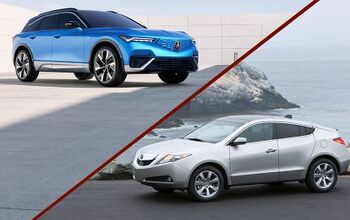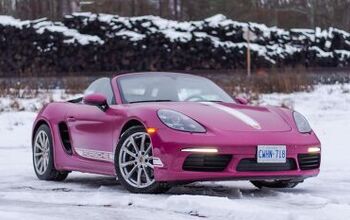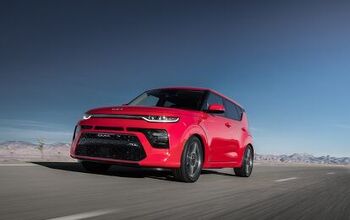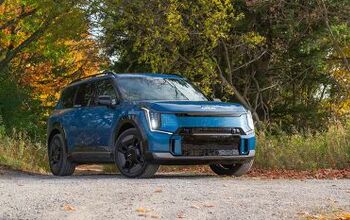Chicago 2010: Nissan 370Z 40th Anniversary Edition, First Live Photos

Tucked away in a quiet corner of the Chicago Auto Show, Nissan displayed, for the first time, its new 370Z 40th Anniversary Edition. Celebrating 40 years since the 240Z landed in the U.S., the 40th Anniversary Edition model starts out as a well-equipped manual-transmission Touring model equipped with the Sport Package which includes the SynchroRev Match transmission, a front lip spoiler and rear spoiler, Nissan’s impressive sport brakes, a limited slip differential and 19-inch Rays forged wheels.
Added to this is a special “40th Quartz” paint job and a red leather interior. Other highlights include red brake calipers; a high luster smoked wheel finish; 40th Anniversary badges on the rear hatch and front strut tower brace; red painted door trim; red stitching on the center stack, shift boot and steering wheel; 40th Anniversary stitching on the seatbacks and floormats; a plaque of authenticity and a special car cover.
Set to go on sale this Spring, the 370Z 40th Anniversary Edition is priced from $38,860.
See our gallery of photos from the car’s debut below:
GALLERY: Nissan 370Z 40th Anniversary Edition
See after the jump for a brief history of the Z car:
A Brief History: Six Generations of Z
The journey from the original 240Z to the current 370Z, of course, made a number of interesting stops along the past 40 years. Interestingly, the 240Z might not have made the journey to America in the first place, if not for the efforts of one man.
Though many, many people were responsible for the design and engineering of the first generation 240Z, its success in North America can be attributed to Yutaka Katayama, who was president of Nissan’s U.S. operations at the time. Known affectionately as “Mr. K,” he was convinced that the company’s new sports car design would be a hit in the U.S. There was just one problem – the vehicle’s name: the Fairlady Z (which is still used in the Japanese market today).
With a name change for this market to “240Z” and some aggressive marketing, including early motorsports success, the Z® became an instant hit – bringing attention and buyers not just to Z, but also to the entire brand.
After overseeing Nissan’s growth in the U.S. in the ‘70s, Katayama returned to Japan and remains, to this day, linked to the Z®’s success here and around the world. On September 15th, 2009, Mr. K celebrated his 100th birthday and received cards and birthday greetings from Z lovers everywhere.
In 1974, as the engine displacement climbed to 2.6 liters the name changed to 260Z. The 2+2 model with an extended roofline and tiny back seat also appeared. In 1975, engine size increased again to 2.8 liters and the name changed to 280Z. Z cars continued to dominate on the racetrack, with Pete Brock, John Morton, Bob Sharp and P.L. (Paul) Newman among the many talented drivers.
Z sales continued to climb with the introduction in 1979 of the new second generation 280ZX. Now priced at just under $10,000, the 280ZX was named Motor Trend “Import Car of the Year” and sales passed 86,000 units. T-tops and a turbocharged engine followed in the early ‘80s.
In 1984, Z engine displacement increased again, with a 3.0-liter V6 replacing the classic Z inline-6, and the 300ZX was born. Also, a specially equipped model celebrating the company’s 50th anniversary and priced at $25,999 was introduced. The 1984 Z was the best selling sports car in America.
The next breakthrough in Z history came in 1990 with the arrival of the totally redesigned, fourth generation 300ZX. Offered in two-seat and four-seat 2+2 models, it offered an unheard of 222 horsepower and a top speed of 150 mph. A few months later, the 300ZX Turbo followed – with 300 horsepower, a 160-mph top speed and a $33,000 price tag.
The 1990 300ZX captured the Z’s second Motor Trend “Import Car of the Year” award, along with a spot on Car and Driver and Road & Track “10 Best” lists. The 300ZX also captured Automobile’s “Design of the Year” and the first of four “All-Stars” awards.
By the mid-‘90s, however, sports car sales in general were slowing and the Z® had lost its “affordable” sports car positioning. With Z sales declining sharply and the core “value” positioning no longer part of the “Z DNA,” sales of the Z in the U.S. slumped and sales were stopped following the 1996 model year. The last 300ZX imported into the U.S. was inducted into the Petersen Automotive Museum in Los Angeles.
The next chapter of the Z history came just before the end of the century. In 1999, Nissan and Renault formed what has become the highly successful Renault-Nissan Alliance.
Mr. Carlos Ghosn was assigned by Renault to head the new management team. Among his first tasks was not just to look at the business aspects, but to find the “soul” of the company. In interview after interview, people inside and outside the company brought up one model to him, one letter: Z.
Development of the new Z began later that year, with the return to the values of the original 240Z – a car that sports car enthusiasts would look forward to driving everyday; quick, inspiring and affordable.
In summer 2002, the Z was reborn with the introduction of the 2003 350Z. It was delivered, as promised, with an MSRP of under $30,000.
Following the 350Z’s unprecedented success, the sixth generation Z, the 2009 370Z was launched last December. Now the little sports car that could comes full circle with the announcement of the 370Z 40th Anniversary Edition.
“It’s almost inconceivable that it has been 40 years since the original 240Z changed the course of Nissan and the concept of affordable, everyday sports cars,” said Castignetti. “In a year, 1969, marked by the first man to walk on the moon, the 240Z made a remarkable first step of its own. Happy anniversary, Z.”

With AutoGuide from its launch, Colum previously acted as Editor-in-Chief of Modified Luxury & Exotics magazine where he became a certifiable car snob driving supercars like the Koenigsegg CCX and racing down the autobahn in anything over 500 hp. He has won numerous automotive journalism awards including the Best Video Journalism Award in 2014 and 2015 from the Automotive Journalists Association of Canada (AJAC). Colum founded Geared Content Studios, VerticalScope's in-house branded content division and works to find ways to integrate brands organically into content.
More by Colum Wood































Comments
Join the conversation